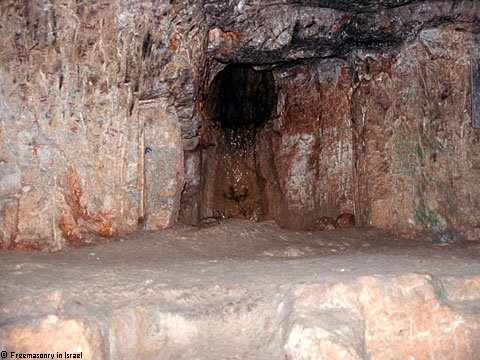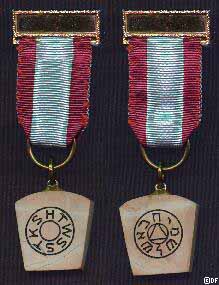

 Freemasonry in Israel
Freemasonry in Israel


 Freemasonry in Israel
Freemasonry in Israel
 Freemasonry in Israel > Articles > Featured > King Solomon's Quarries
Freemasonry in Israel > Articles > Featured > King Solomon's Quarries
King Solomon's Quarries
Jerusalem, Israel
Israel J. Herman, MEComp
PFGP (1989), Supreme Grand Royal Arch Chapter of the State of Israel
Reprinted from The Israeli Freemason

The cave opening is beneath the north wall of the Old City of Jerusalem; close to the Damascus Gate. From the entrance, the main path leads south for nearly 225 meters (~740 ft) till it reaches the main large cave called "The Freemasons Hall." From this hall, it bears east, leading to the dripping spring and the lowest place of the cave. The known area of the cave is about 900 m² (~10,000 square feet).
The cave contains a number of different kinds of rock. The main type being white massif limestone, locally called "Melekeh," meaning "Royal." This stone is beautiful for building, and although not too hard, it does not flake off. Very large building blocks have been quarried from it. The opening of the cave consists of a denser limestone, also white, locally called "Mizzi-helou," meaning "sweet" (that is "soft"). It is very easily worked, but cannot be used in large blocks. Likewise, there is also iron-containing limestones called "Mizzi-ahmar," meaning "red," and other harder stones, too hard for cutting, called "Mizzi-Yehudi," meaning "Jewish."
One of the methods for hewing the stones was to carve broad slits along the rock face, and to drive dry wooden wedges into them. Water was then poured over the dry wedges, so causing them to swell. The resulting pressure then cracked the stone along the slits. This primitive method of quarrying was quite effective, and traces of it can still be found in the cave.
The cave-quarry is quite close to the Temple Mount, and even, large stones could have been transported to the Temple construction site. Furthermore, it is known from the first book of Kings that it was forbidden to use any iron tools in the actual 'on site' construction of the Temple, nor was the sound of such permitted to be heard. This cave would be the ideal place for quarrying and dressing the stones for the Temple, while meeting with those requirements.
Josephus Flavius, in his book "Wars of the Jews" (against the Roman conquerors), refers to the cave as the "Royal Caverns." The name originating, as mentioned previously, from the "Melekeh" or "Royal" limestone quarried in it. This later led to their being called "King Solomon's Quarries." It should be possible to prove whether the stones used in the building of the Temple did actually come from these caves. At the moment, this is still an unproven tradition. What is known is that the stone structure in the cave is identical with that of stone remnants preserved from King Solomon's Temple.
This cave may really be King Solomon's quarries, anyway being a real quarry and in the vicinity of the Temple Mount. This cave has special meaning for Freemasons in general, and for Mark Master Masons and the Royal Arch in particular. Starting in the days of the British Mandate, the cave was used for the ceremony of Mark Master Masons. This was temporarily suspended between the years 1948-1968. The impressive ceremony of the consecration of the Supreme Grand Royal Arch Chapter of the State of Israel was carried out in the caves in the spring of 1969, and ever since then, the Mark degree has been performed in the caves on the average of once a year.
The Bible, both in the second book of Kings and in Jeremiah, tells us that King Zedekiah fled from the Chaldeans by night, by the way of the gate between the two walls, by the King's garden. But eventually, the Chaldeans overtook him in the plains of Jericho. Arising from this, the medieval commentators of the Bible, Radak and Rashi, mention the following legend: "There was a cave from the palace of Zedekiah to the plain of Jericho and he fled through the cave, and G-d caused a buck to walk on the roof of the cave and the Chaldeans followed the buck. When they reached the cave opening in the plain of Jericho, Zedekiah was emerging. They saw him and captured him." This is the reason that the caves are also called "Zedekiah's Grotto." At the present time, the caves end soon after the dripping spring. A legend says that these drops of water are the "tears" of King Zedekiah, which he shed while trying to escape from the Chaldeans. No other exit than the entrance opening is known today, let alone an underground route all the way to the plains of Jericho.

In the 10th century, the present Damascus Gate of the Old City of Jerusalem was called "the Gate of the Grotto." In the 15th century, the cave was used as a wool storehouse and called "the Cotton Grotto."
The cave opening was sealed by the Turks in about 1542, while rebuilding the walls of Jerusalem. The cave was accidentally rediscovered in the spring of 1854 by Bro. Dr. Barclay, an American physician, while on a walk with his sons and dog. The dog, on a fox's scent, started digging and entered the cave. Subsequently, Dr. Barclay explored the cave and later it was reopened.
During the British Mandate, large stones were quarried from the rock in the cave and sent to various countries to serve as cornerstones for newly erected Masonic Lodges.
Legends tell that when the Roman legions, under the command of Titus, placed Jerusalem under siege, the priests of the Temple hid Holy Utensils and Instruments of the Temple deep down the cave. If this is true, these treasures have yet to be discovered.
Bibliography
Copyright © 1997- Freemasonry in Israel. All rights reserved. • Valid XHTML, CSS, WAI, Unicode.
Reproduction, distribution, or publication of any part of this web site, in any form or by any means, constitute infringement of copyright laws.
This web site is NOT the official site, statement, or opinion of any Grand Lodge, Lodge, or individual. All contributions are voluntary and represent only good intention and effort.